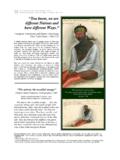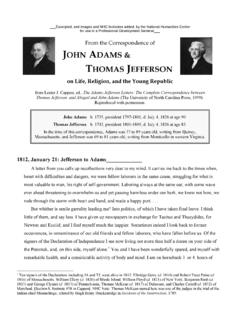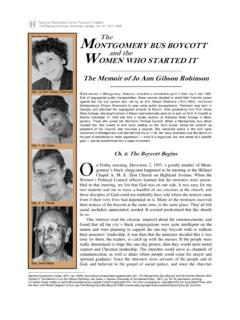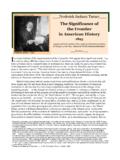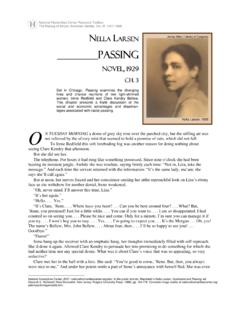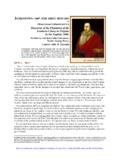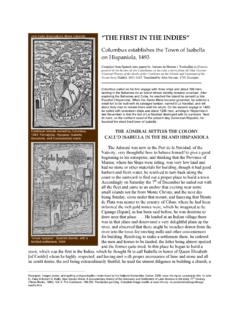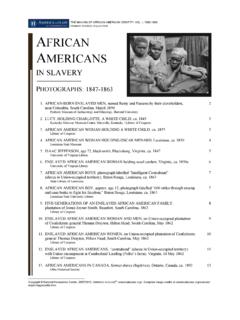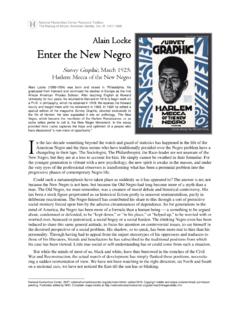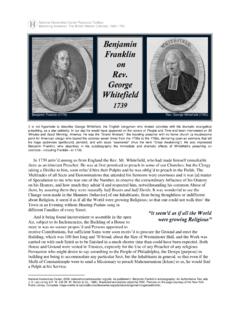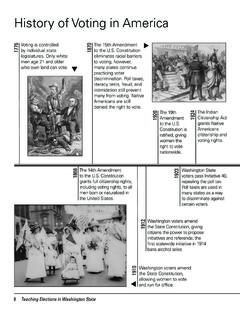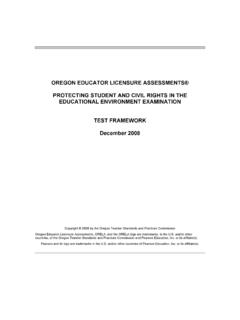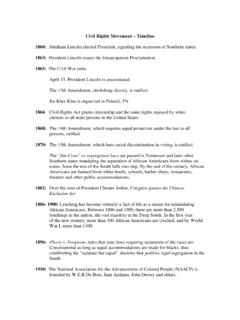Transcription of The Long Civil Rights Movement and the Political Uses of ...
1 The long Civil Rights Movement and the Political Uses of the Past Jacquelyn Dowd Hall The black revolution is much more than a struggle for the Rights of Negroes. It is forcing America to face all its interrelated flaws racism, poverty, militarism, and materialism. It is exposing evils that are rooted deeply in the whole structure of our society .. and su^ests that radical reconstruction of society is the real issue to be faced. Martin Luther King Jr. Stories are wonderful things. And they are dangerous. Thomas King The Civil Rights Movement circulates through American memory in forms and through channels that are at once powerful, dangerous, and hotly contested. Givil Rights memorials jostle with the South's ubiquitous monuments to its Confederate past.
2 Exemplary scholarship and documentaries abound, and participants have pro- duced wave after wave of autobiographical accounts, at least two hundred to date. Images of the Movement appear and reappear each year on Martin Luther King Jr. Day and during Black History Month. Yet remembrance is always a form of forget- ting, and the dominant narrative of the Civil Rights Movement distilled from history and memory, twisted by ideology and Political contestation, and embedded in heri- tage tours, museums, public rituals, textbooks, and various artifacts of mass cul- ture distorts and suppresses as much as it reveals.'. Jacquelyn Dowd Hall is Julia Cherry Spruill Professor of History at the University of North Carolina and director of the Southern Oral History Program.
3 This article is a revised version of the presidcnrial address delivered to the convention of the Organization of American Historians in Boston on March 27, 2004. Writing this essay led me to conversation with a far-flung network of friends and colleagues, and 1 thank them for their encouragement and generous sharing of ideas. Among them were Jefferson Cowie, Jane Dailey, Matthew Lassiter, Nelson Lichtenstein, Eric Lott, Nancy MacLean, Bryant Simon, and Karen Kruse Thomas. Laura Edwards, Drew Faust, Glenda Gilmore, Jeanne Grimm, Pamela Grundy, Bethany Johnson, Robert Korstad, Joanne Meyerowitz, Timothy McCarthy, Joe Mosnier, Karhryn Nassrrom, Delia Pollock, Jennifer Ritterhouse, and Sarah Thuesen also offered astute comments on the manuscript in its various iterations.
4 I benefited especially from Bethany Johnson's research and editorial skills, and Elizabeth More provided additional research assistance. A. fellowship at the RadclifFe Institute for Advanced Study provided an ideal community in which to think and write. ' On Civil Rights autobiographies and histories, see Kathryn L. Nasstrom, "Between Memory and History: Autobiographies of the Civil Rights Movement and the Writing of a New Civil Rights History," National Endow- ment for the Humanities Lecture, University of San Francisco, April 29, 2002 (in Jacquelyn Dowd Hall's posses- sion); Steven F. Lawson, "Freedom Then, Freedom Now: The Historiography of the Civil Rights Movement ,". American Historical Review, 96 (April 1991), 456-71; Adam Fairclough, "Historians and the Civil Rights Move- ment," Joumal of American Studies, 24 (Dec.)
5 1990), 387-98; Charles M. Payne, I've Got the Li^t of Freedom: The The Journal of American History March 2003 1233. 1234 The Journal of American History March 2005. Centering on what Bayard Rustin in 1965 called the "classical" phase of the strug- gle, the dominant narrative chronicles a short Civil Rights Movement that begins with the 1954 Brown v. Board of Education decision, proceeds through public protests, and culminates with the passage of the Civil Rights Act of 1964 and the Voting Rights Act of 1965.' Then comes the decline. After a season of moral clarity, the country is heset by the Vietnam War, urban riots, and reaction against the excesses of the late 1960s and the 1970s, understood variously as student rebellion, black militancy, feminism, busing, affirmative action, or an overweening welfare state.
6 A so-called white backlash sets the stage for the conservative interregnum that, for good or HI, depending on one's ideological persuasion, marks the beginning of another story, the story that surrounds us now. Martin Luther King Jr. is this narrative's defming figure frozen in 1963, pro- claiming "I have a dream" during the march on the Mall. Endlessly reproduced and selectively quoted, his speeches retain their majesry yet lose their Political bite. We hear little of the King who believed that "the racial issue that we confront in America is not a sectional but a national problem" and who attacked segregation in the urban North. Erased altogether is the King who opposed the Vietnam War and linked rac- ism at home to militarism and imperialism abroad.
7 Gone is King the democratic socialist who advocated unionization, planned the Poor People's Campaign, and was assassinated in 1968 while supporting a sanitation workers' strike.'. By confming the Civil Rights struggle to the South, to bowdlerized heroes, to a sin- gle halcyon decade, and to limited, noneconomic objectives, the master narrative simultaneously elevates and diminishes the Movement . It ensures the status of the classical phase as a triumphal moment in a larger American progress narrative, y^x it undermines its gravitas. It prevents one of the most remarkable mass movements in American history from speaking effectively to the challenges of our time. Organizing Tradition and the Mississippi Freedom Struggle (Berkeley, 1995), 413-41; Charles W, Eagles, "Toward New Histories of the Civil Rights En.
8 " foumal of Southern History, 66 {Nov. 2000), 815-48; and Kevin Gaines, "The Historiography of the Struggle for Black Equality since 1945," in A Companion to Post-19-45 America, ed. Jean-CKristophc Agnew and Roy Rosenzweig (Maiden, Mass., 2002), 211-34. In contrast to the vast literature on what the Movement was and did, the scholarship on how it is remembered is scattered and chin. For examples, see David A, Zotiderman, review of the Martin Luther King Jr. National Historic Site, Birtningham Civil Rights Institute, and National Civil Rights M\ise.\im. Joumal of American History, 91 (June 2004), 174 83; Kathryn L. Nassrrom, "Down to Now: Memory, Narrative, and Wotnen's Leadership in the Civil Rights Movement in Atlanta, Georgia.}
9 " Gender and History. II (April 1999), 113-44; Terrie L. Epstein, "Tales from Two Textbooks: A. Comparison of the Civil Rights Movement in Two Secondary History Textbooks," Social Studies. 85 (May June 1994), 121-26; William A. Link, review of the film The Road to Brown, by William A. Ellwood, Mykola Kulish, and Gary Weimberg, History of Education Quarterly, 31 (Winter 1991), 523-26; and an anthology in progress: Leigh Raiford and Renee Romano, eds., "'Freedom Is a Constant Stru^le': The Civil Rights Movement in United States Memory" (in Leigh Raiford and Renee Romano's possession). ^' Bayard Rusrin, Z)(J ' The Collected Writings of Bayard Rustin {C}iica:go, 1971), 111-22,esp. 111. ' Martin Luther King Jr., "The Rising Tide of Racial Consciousness (I960).
10 " in I Have a Dream: Writings and Speeches That Changed the World, ed. James Melvin Washington (San Francisco, 1992), 67. For early protests against the tendency to idolize King and to ignore his radicalism and that of the grass roots, see "A Round Table: Martin Luther King ]T." Journal of American History 74 (Sept. 1987), 436-81. For a call for attention to the later King years, see Michael Honey, "I^bor and Civil Rights Movements ar the Cross Roads: Martin Luther King, Black Workers, and the Memphis Sanitation Strike," paper delivered at the annual meeting of the Organization of American Historians, Memphis, Tenn., April 2003 (in Hall's possession). Civil Rights and the Political Uses of the Past 1235. While the narrative I have recounted has tnuitiple sources, this essay emphasizes how the Movement 's meaning has been distorted and reified by a New Right bent on reversing its gains.
